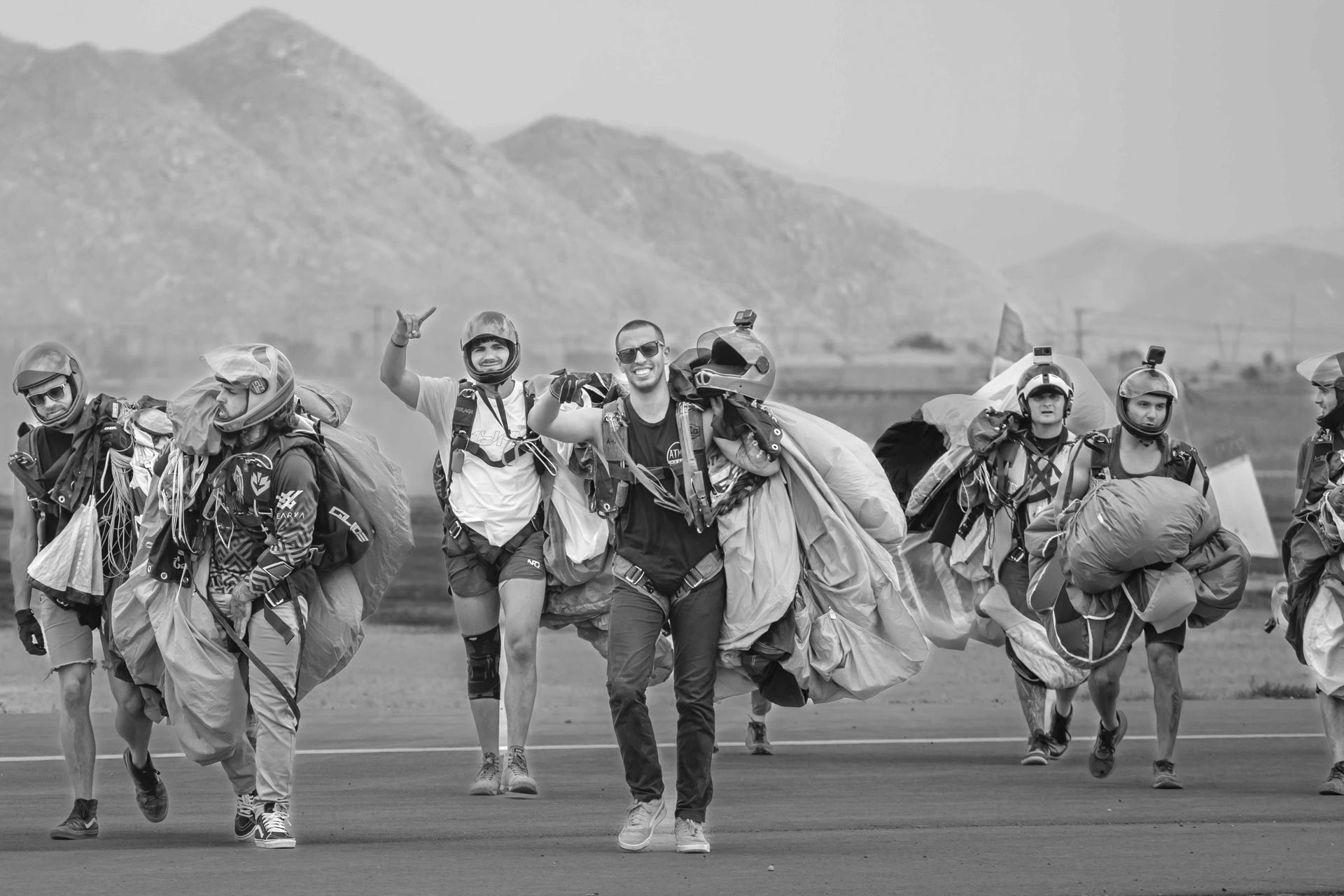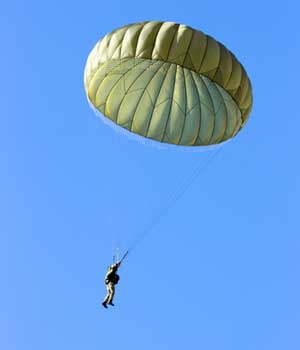10 Important Moments in Skydiving History
Canopy Piloting
Posted by: Skydive Perris
9 years ago

Skydiving has evolved significantly since the first parachute was designed back in the 1480s. Today, sport skydiving exists as a hobby, participated in by thousands of skydivers across the globe, and tandem skydiving appears on most people’s bucket lists.
Here are ten key moments in skydiving history that brought us to where we are today.
1483: Leonardo Da Vinci and the World’s First Parachute
Leonardo Da Vinci (Leo to his friends) was an incredibly talented artist with an eye for detail. But even more than that, he was an exceptional scientist and engineer.
His intricate study of the world around him led him to create great works of art. It also led him to theorize much about the human anatomy, architecture, sculpture, music, engineering, geology, hydraulics and the military arts.
He took a keen interest in flight and sketched a conical parachute design in 1483, which is recognized as the first parachute. An accompanying note read: “If a man is provided with a length of gummed linen cloth with a length of 12 yards on each side and 12 yards high, he can jump from any great height whatsoever without injury.”
In the year 2,000, Adrian Nicholas became the first man to jump with the Da Vinci parachute, proving that it was, in fact, the first working parachute ever designed.
1911: The World’s First ‘Skydiver.
It was sometime between Da Vinci’s sketch and the first skydive as we know it today (though some scripture suggests parachute descents were made in China in the interim). Credit for the first modern skydive is split between Grant Morten and Albert Berry, with controversy rife to this day over who actually jumped first.
Morten was reportedly the first skydiver when he jumped from a Wright Model B airplane over Venice Beach, California using a folded silk parachute. It has been argued that he was actually beaten to it by Berry, a US Army Captain, who jumped in March 1912. Records aren’t clear, meaning we’ll probably never know – but suffice to say, the first skydive was made sometime around 1911-1912!
1914-1945: Skydiving and the Military
Much of skydiving’s development from that point on can be attributed to the use of parachutes in the World Wars. During this time, it was widely recognized that parachutes served a great purpose as a life saving device. It was first proposed by American General Billy Mitchell that parachute troops be used in 1917, with the Italian military credited with the first combat jump in 1918.
In 1933, the Soviets staged the first mass parachute drop when they dropped 62 parachutists from three bombers. They greatly expanded their parachute units and in 1936 dropped 1,800. Parachute regiments became commonplace in World War II, and many armies still retain their parachuting arms to this day.
With parachutes used so much in war, their development was accelerated. When the war ended, the parachutes became available for non-military use, helping to bring parachuting to the masses.
1946: USPA (United States Parachute Association) founded
The USPA is the governing body for the sport of skydiving in the USA. The USPA provides guidance and sets rules in place to keep the sport safe, and oversees its ongoing progression. Today, the USPA is a huge part of skydiving in this country and is the body which awards instructor ratings and skydiving qualifications.
The USPA was founded in 1946, in Mineola, New York, as the National Parachute Jumpers-Riggers, Incorporated. At the time, it represented around 100 members. It was renamed the Parachute Club of America in 1957 and renamed itself again to the United States Parachute Association in 1967. Its inception was an important point in skydiving as it marked the recognition of skydiving as a sport and hobby.
The 1960s: First Ram-Air Parachute Design
The first parachutes were round in shape. This meant they could pivot on their centre, but controlling their speed, direction, and glide ratio was pretty much impossible.
This led to the invention of the first ram-air parachute design by Domina Jalbert in the 1960s. Jalbert was a kite maker, who recognised that the kite shape was much more efficient as a wing. This is because the ram-air (or parafoil) design allows air in through the front ‘cells’ and then retains that air, forming a rigid wing that can be controlled by its pilot much more effectively than round parachutes ever could.
Today, the vast majority of skydivers use ram-air parachutes, with which they perform high-performance ‘swoop’ landings as well as being able to adjust their speed and descent.
1964: First Vertical Wind Tunnel Flight
Skydiving wind tunnels are what we call vertical wind tunnels (VWT). These differ from traditional horizontal wind tunnels which are used to test the aerodynamics of planes or cars.
The first person to fly in a vertical wind tunnel did so in 1964 in Ohio. It was a flight that started a new era for indoor body flight. The first wind tunnel intended for people to fly in was built in 1978 by John St Germain who wanted his children to experience freefall in what he considered being a safer environment.
Since then, indoor skydiving has progressed significantly. Dozens of wind tunnels now exist in the world and many of those are intended solely for the use of skydivers and those who want to experience body flight. Skyventure at Skydive Perris was one of the first wind tunnels for skydivers and remains one of the only wind tunnels situated on a skydiving drop zone. You can find out more about our wind tunnel here.
1978: The Three Ring Release System
The three-ring release system was invented by Bill Booth and patented in 1978 as a means of attaching (and detaching) a canopy from its harness.
It is accepted by skydivers that their main parachute doesn’t always work. This is why modern skydivers jump with a spare, or reserve parachute. But in order to use their reserve, skydivers must first detach the malfunctioning main canopy.
Prior to the invention of the three-ring release system, this detachment was done using capewells, which were cumbersome and could malfunction themselves. The three ring system makes cutting away the malfunctioning parachute much quicker and easier; this is because the design of the system means the mechanical advantage is multiplied by each ring in the series, allowing for the force needed to cut away to be greatly reduced.
The 3-ring is widely recognised as one of the greatest safety innovations in the history of skydiving.
1980s: Tandem Skydiving Receives Sport Status
Tandem skydiving is a type of skydiving where the ‘student’ jumps from a plane attached to a qualified instructor, sharing one set of parachuting equipment between them. These days, tandem skydiving is the most popular way to experience the first jump – but it’s not always been that way!
In the early 80s, tandem skydiving was still in ‘experimental’ status. This means it was being tested but had yet to be classified as a full sport. The FAA (Federation Aviation Administration) waived the experimental status, opening the door for tandem skydiving to grow in popularity.
1989: Invention of the Cypres AAD
As skydiving has progressed, there have been significant improvements in the safety of the sport. The invention of the Cypres AAD is recognized as one of the most important of these safety innovations.
An AAD, or automatic activation device, is a small device which monitors air pressure and speed. It automatically opens the reserve parachute if it finds it is still falling at freefall speeds by a given altitude. This means that it will ensure the skydiver has a parachute over their heads even if they are knocked unconscious or lose altitude awareness during their descent.
Prior to the invention of the CYPRES, there were a number of AADs on the market but none were considered reliable. Today, the majority of skydivers use AADs, primarily from CYPRES and its rival company Vigil.
1991: Point Break Brings Skydiving to the Masses
Point Break was a film first released in 1991 and later remade in 2016. Its storyline revolved around an FBI agent who goes undercover to catch a gang of surfers who might be bank robbers.
In a plot similar to that of the later film, Cutaway, the main protagonist finds himself drawn into the adrenaline-fuelled lifestyle of the criminals he has been sent to catch. The group persuades the lead character, played by Keanu Reeves, to ‘jump from a perfectly good airplane’ in a scene which shows the skydivers talking to one another mid jump and having an awesome time!
Point Break was one of the first major box office hits to show skydiving, bringing the sport to the masses (although its viability as a true representation of skydiving is questionable!).
Are you Ready to Skydive?
Skydiving is an amazing experience and one which has evolved over more than 500 years. Each year, approximately 500,000 people in the US try skydiving for the first time. Today, more than 10 million men and women throughout the country can say they’ve made at least one skydive.
If you’re ready to join them, book your tandem skydive today. If you’ve got any questions, our team is here to help – contact us!











